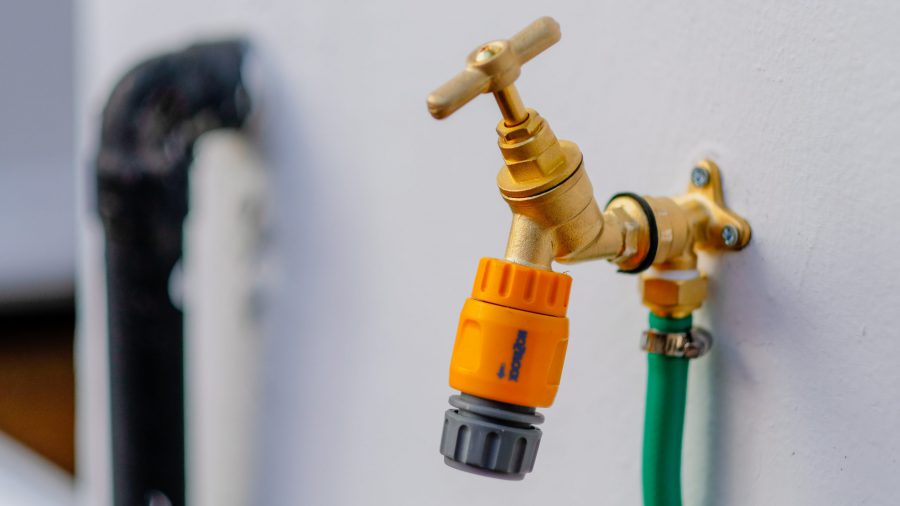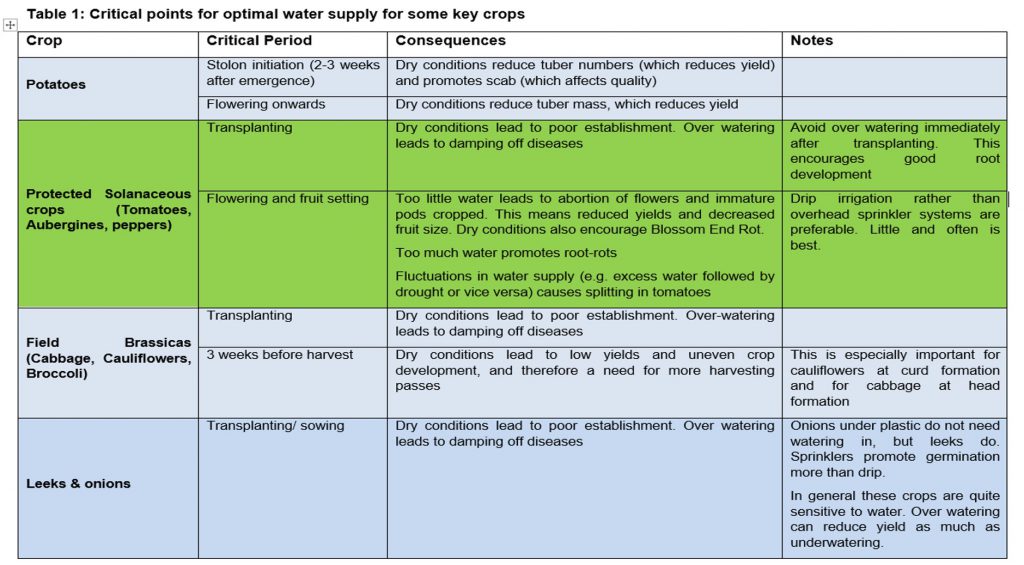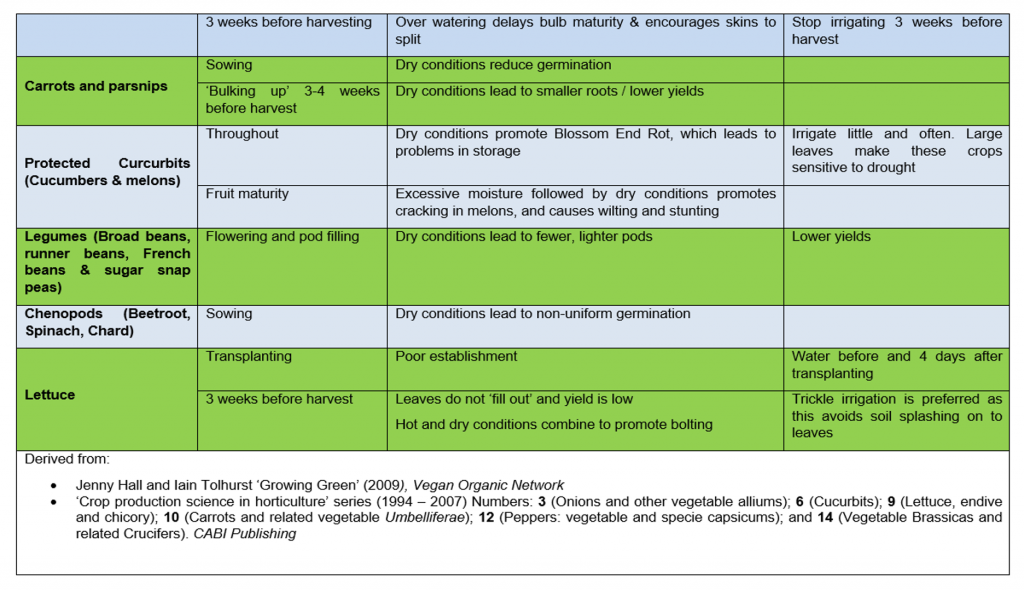
Introduction
Rainfall in Wales varies widely. The highest rainfall is in the central upland areas from the Brecon Beacons to Snowdonia (where average annual totals exceed 3000 mm). Coastal areas and North East Wales by contrast, receive less than 1000 mm a year. Throughout Wales the wettest months of the year are from October to January (further details here).=
With the impact of climate change weather patterns are becoming increasingly erratic. In the last 8 years, parts of the UK have seen the wettest winter (2014), the driest spring (2011) and the driest summer (2018) since records began in 1766. While most growers in Wales would not see water as a scarce resource, many are starting to view it as an increasingly unpredictable one, and the resilience of businesses in respect to water is becoming more important.
The response of governments, including the Welsh Government, is becoming increasingly urgent. This is reflected in:
• The Welsh Government heir declaration of a Climate Emergency in April 2019
• A strong emphasis on water management and quality in the proposals for agricultural policy post Brexit
• A strengthening of the Water Framework Directive in 2017. Of most direct relevance to growers, new regulations have been introduced to manage the abstraction of water from springs, water bodies and boreholes.
• The publication of the State of Natural Resources report by Natural Resources Wales and the subsequent Natural Resources Policy
• A programme of work, led by Natural Wales to tackle climate change
The impact of water stress
The appropriate level of soil moisture is vital for producing high quality, healthy, vigorous crops. In general terms, dry conditions can lead to:
• Poor germination / establishment
• Reduced nutrient uptake, and therefore low vigour and reduced yield (nutrients, especially Nitrogen, are taken up by the plant in solution)
• Abortion of flowers / fruits
• A general weakening of the plant, making it more susceptible to pests, diseases and weeds.
Waterlogging limits oxygen supply to the roots and prevents carbon dioxide from diffusing away, effectively drowning the plant. Most crops will survive short term waterlogging, but root function is reduced under these conditions and this encourages root diseases such as damping off in seedlings and root-rots in more developed plants.
Water management
While the appropriate amount of water is desirable throughout the growing season, for many crops there are particular points at which an optimal supply of water is critical. In general, these are at
• Sowing / transplanting
• Flowering and fruit set
• Periods of ‘bulking up’ for root crops and heading brassicas (cabbage & cauliflower) – typically 3 or 4 weeks before harvest.
Table 1 below provides more details for some key crops. Successful water management is all about prioritising your water/ irrigation resources to meet all your crops needs at these specific points while managing your soils to ensure good drainage to prevent waterlogging.
Table 1: Critical points for optimal water supply for some key crops


Irrigation systems
Broadly speaking there are two types of irrigation system, overhead and drip (sometimes known as trickle) systems.
Overhead systems
• These apply water from above the crop
• Rain guns and sprinkler systems are the most common
• Boom irrigation systems, tractor mounted (with a hose reel connected to the water source) or self-propelled, are becoming increasingly popular because:
o Evaporative losses because they force the water down into the crop, as opposed to throwing it up in the air
o Larger volumes over shorter periods can be placed more accurately
o They operate at lower pressures
However, they are significantly more expensive, and self-propelled systems work best in large square/ rectangular fields, which means they are not always appropriate in Wales.
Drip or trickle systems
• These deliver water directly to the base of the plant usually at very low rates (2 – 20 l/ hr) through a system of small diameter pipes
• They are highly efficient because they deliver the water directly to the roots, and losses to evaporation are very low compared to overhead systems
• Water is not sprayed so humidity in the surrounding area is not significantly increased. This slows down the spread of many plant diseases and avoids pathogens and soil being soil splashed up on the crop (important for leafy salads)
• Drip systems are widely used in protected cropping (glasshouses and poly tunnels)
• They are used in field systems but can be difficult to install on a large scale and may interfere with other operations such as mechanical weeding.
Growers often use a combination of overhead and drip / trickle systems. In protected cropping, overhead systems are used where a relatively large amount of water is required uniformly, for instance prior to sowing. Trickle / drip systems are then used once the crop is established.
Water sources and storage
On most horticultural holdings the water used is either from water mains or abstracted from springs, water bodies (rivers, lakes etc) and boreholes.
Abstraction licences
• The regulatory system for abstraction has recently been reviewed and updated, and number of key changes were introduced:
o Abstraction of more than 20 cubic metres (4,400) gallons per day, then you need a licence from Natural Resources Wales
o Before 2018 some water abstraction activity (including for trickle irrigation systems) was exempt from the need for a licence. Regulatory changes now require many previously exempt abstractors to apply
o Unused licences are being revoked and under-used licences reduced.
• Changes took effect from 1 January 2020, so if growers are already operating a horticultural business, you should be aware of and have acted on the changes. If you are setting up a new business/ expanding your existing operation, make sure you are compliant with new regulations and licencing requirements.
Storage
• With careful management and judicious use, most growers find that supplies of water from mains and water bodies are adequate but in the light of a changing climate an increasing number of growers are setting up rainwater collection systems from the roofs of sheds, farm buildings and houses
• Systems vary in complexity from an above ground tank collecting water off a roof area to supply gravity-fed troughs or crops, to sophisticated systems with a large underground tank and pumps to distribute the collected water to where it is needed.
• There is a great deal of information and guidance available on the Internet and the market for a wide range of systems is well developed and competitive
• Water collection from polytunnels is sometimes overlooked, because of the perception that the quantity of water collected is small. In fact with an annual rainfall of 1200mm (fairly typical of West Wales), a 50m x 10m polytunnel can collect 600,000l a year. Guttering systems are widely available and are relatively easy to install on multi-span and straight sided tunnels. Gutters can be fitted to standard tunnels with a little modification. Wooden batons are attached to the frame with U bolts and the guttering clips screwed on the batons. This article provides practical guidance

Managing soil for optimal moisture levels
The quantity of water that goes into the soil system, whether through rainfall or irrigation, is only part of the equation. The other aspect is the extent to which soil can hold on to moisture in dry conditions and drain away excess water in wet conditions.
• Soil texture is very important: light sandy soils retain less moisture than heavier soils. Texture is related to the underlying geology and there is very little growers can do to change it – though its effects can be mitigated
• Soil organic matter plays a key role. It acts a little like a sponge, absorbing moisture and releasing it slowly over a period of time. A 1% increase in organic matter increases the water holding capacity by between 155,000 – 350,000 l/ ha, depending on assumptions on which the estimate is based
• Organic matter is the ‘glue’ that holds soil aggregates together in an open, porous structure. This improves the drainage, preventing waterlogging and the problems associated with excess water
• Avoiding structural damage to soils is also vital to improve drainage. This is largely a matter of not cultivating in wet conditions and minimising compaction from machinery by (see Guide No. 1 this series, Soil Management for Horticulture and Soil Health and Water Supply for details)
Post-harvest water use
For fresh packed fruit and vegetables, most water is used for washing and cooling. Hydrocooling, as the name suggests, is using cold water to reduce the temperature of freshly harvested produce to lengthen its shelf life and is discussed in detail in guide No. 4. Only potable (safe and clean) water is used for hydrocooling, and the volumes involved are relatively small, so the implications for water use and quality are fairly small.
Water is used in a variety of stages including primary cleaning, sorting and grading. Consider
• Prioritising dry cleaning methods such as sifting, brushing and vibration with sieving to remove the bulk of soil
• Using taps with automatic shut-off valves and where appropriate high water pressure with optimised nozzles
• Separating cooling water from process water to enable recycling of wastewater
Case study – Parc y Dderwen: Reed bed systems for sustainable water management
Parc y Dderwen, run by Lauren Simpson and Phil Moore, produces fermented vegetable products. Last year they had their application for a One Planet development near Clynderwen approved, and by next year will be growing their own produce and using their own on-site commercial kitchen.
They are constructing a Horizontal flow gravel reed bed system that can serve several functions:
Cleaning grey water from the onsite commercial kitchen and house
Providing a water source for irrigation
Creating a wetland habitat to promote biodiversity
The reed bed is populated with, in this case, Common reed (Phragmites australis) which helps to oxygenate the waste. This in turn promotes microorganisms in the bed that break organic matter, producing clean water suitable for irrigation. At the same time, the system creates a diverse habitat that will support a wide range of species including insects and wetland birds.
An appropriate size hole is dug according to a standard formula (5m2 x per maximum persons in the dwelling x 0.6), at a depth of 70cm with a 45o angle at the sides. It is lined with plastic (layers of recycled polytunnel plastic in their case). Input and output pipes are installed, and the hole filled with clean gravel in which the reeds take root. The grey water is first filtered through a simple bucket filter filled with straw to collect detritus and then flows into the reed bed. The flow is designed to spread through the gravel slowly and across the whole width of the bed before exiting into a soakaway area planted with willow. It is at the soakaway stage that irrigation water could be extracted for watering crops.
Grey wastewater can be delivered into the reed bed either below the water level via a horizontal feeder trench as with this system or alternatively from above the surface via a vertical flow system.
Monitoring
• Installing a meter is essential to monitor water usage
• Regular, preferably daily, observations of the crops will enable timely responses to water challenges, ensuring optimal yields/ quality
• For larger operations, systems that automatically monitor soil moisture and schedule irrigation accordingly are available (see Water management for vegetable field crops for more information).
• Keep records of how much water was supplied when for each crop, and relate them back to yield/ quality/ pest and disease incidences at the end of the season, and make appropriate changes to your management of subsequent crop
• Web based environmental foot print calculators, such as the Cool Farm Tool described in Guide No 9 in this series are available to help you identify opportunities to maximise your water use efficiency.
Resources
• A farmer’s guide to organic fruit and vegetable production Organic Centre Wales http://www.organiccentrewales.org.uk/uploads/hortguide_eng.pdf
• Catching water off a polytunnel Jonathon Smith, Organic Grower
http://sustainablefarming.co.uk/susfarming/wp-admin/upload.php?item=254
• Irrigation Best Practice: Water Management for Field Vegetable Crops; A Guide for Vegetable Growers, ADAS
http://www.ukia.org/pdfs/water%20management%20for%20field%20vegetable%20crops.pdf
• Natural Resources Policy, Welsh Government https://gov.wales/sites/default/files/publications/2019-06/natural-resources-policy.pdf
• Our role in managing and adapting to climate change, Natural Resources Wales
https://naturalresources.wales/about-us/what-we-do/climate-change/?lang=en
• Soil health and water supply AHDB Horticulture
https://ahdb.org.uk/knowledge-library/soil-health-and-water-supply
• Soil Management for Horticulture AHDB Horticulture https://horticulture.ahdb.org.uk/publication/soil-management-horticulture
• State of Natural Resources report, Natural Resources Wales
• https://cdn.naturalresources.wales/media/682366/sonarr-summary-september-2016-edited-august-2017.pdf
• Water abstraction licences for previously exempt activities, Natural Resources Wales
https://naturalresources.wales/permits-and-permissions/water-abstraction-and-impoundment/?lang=en;
